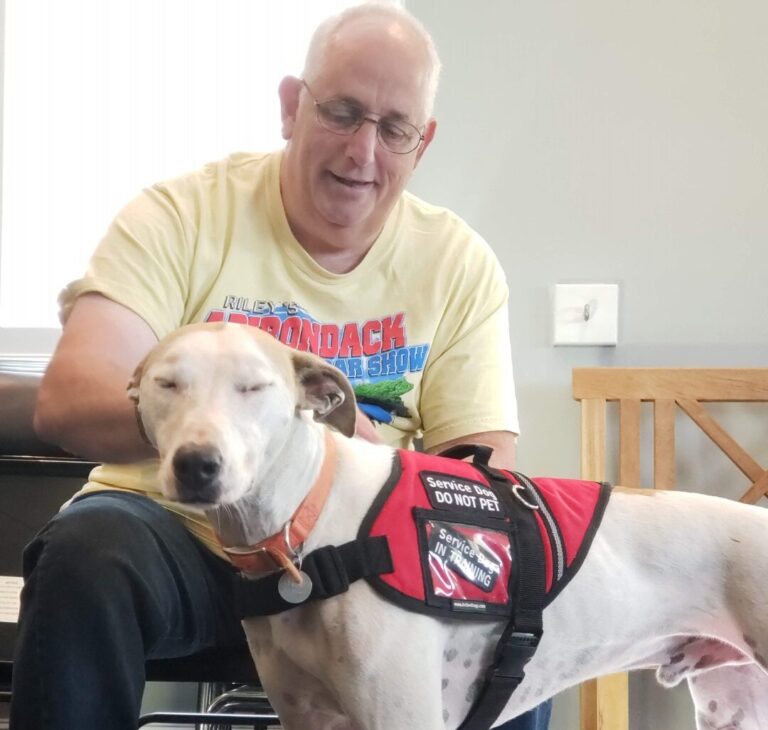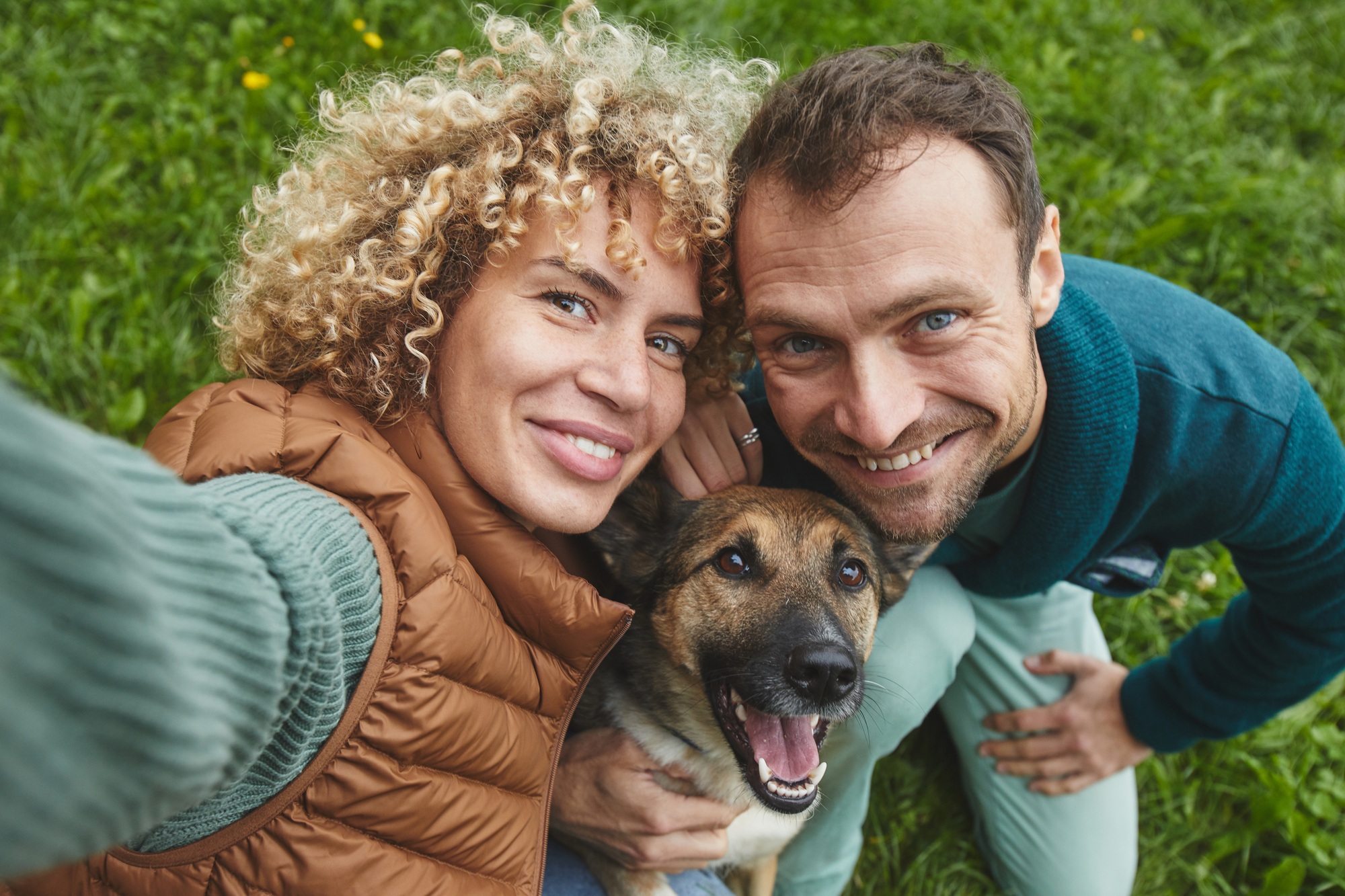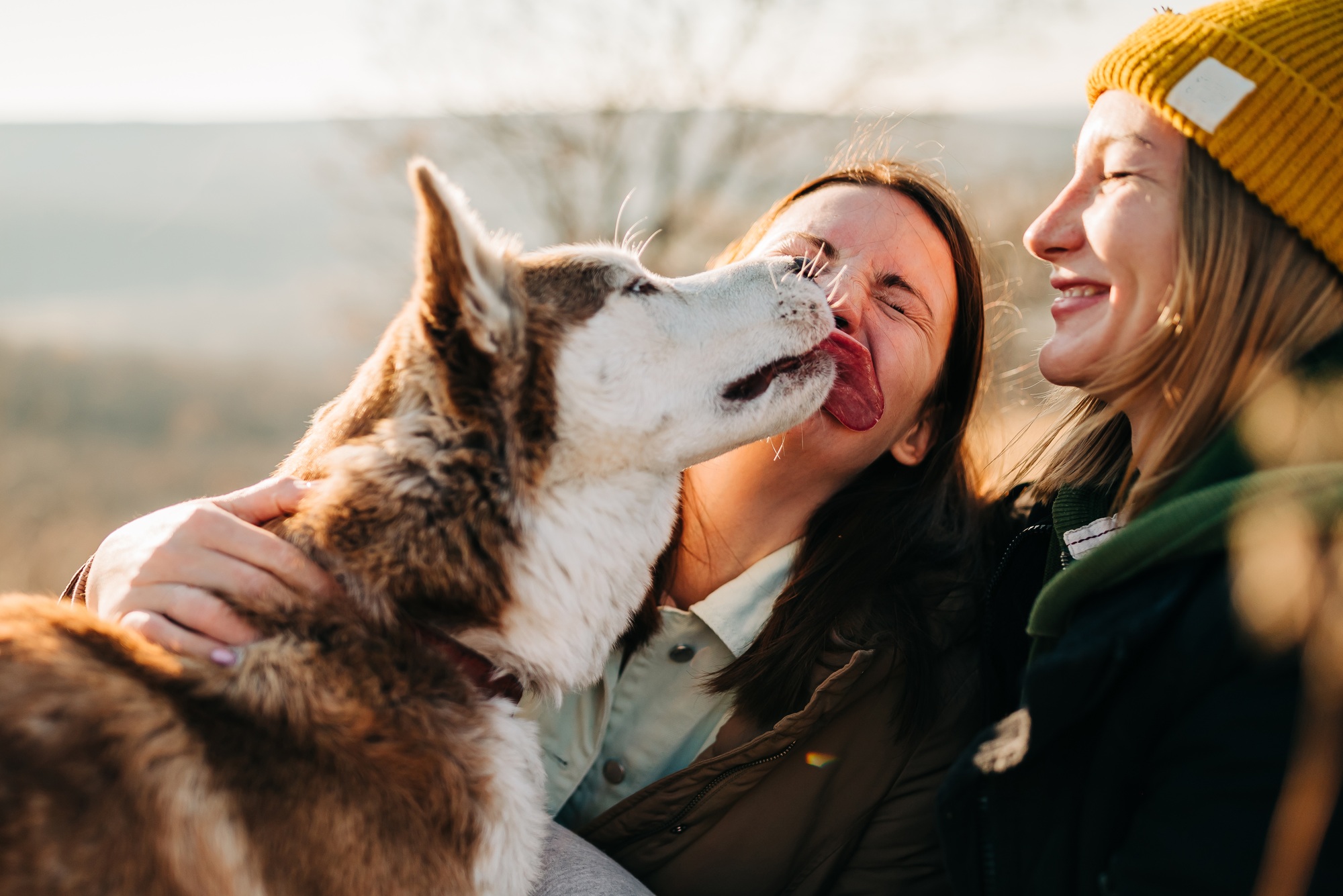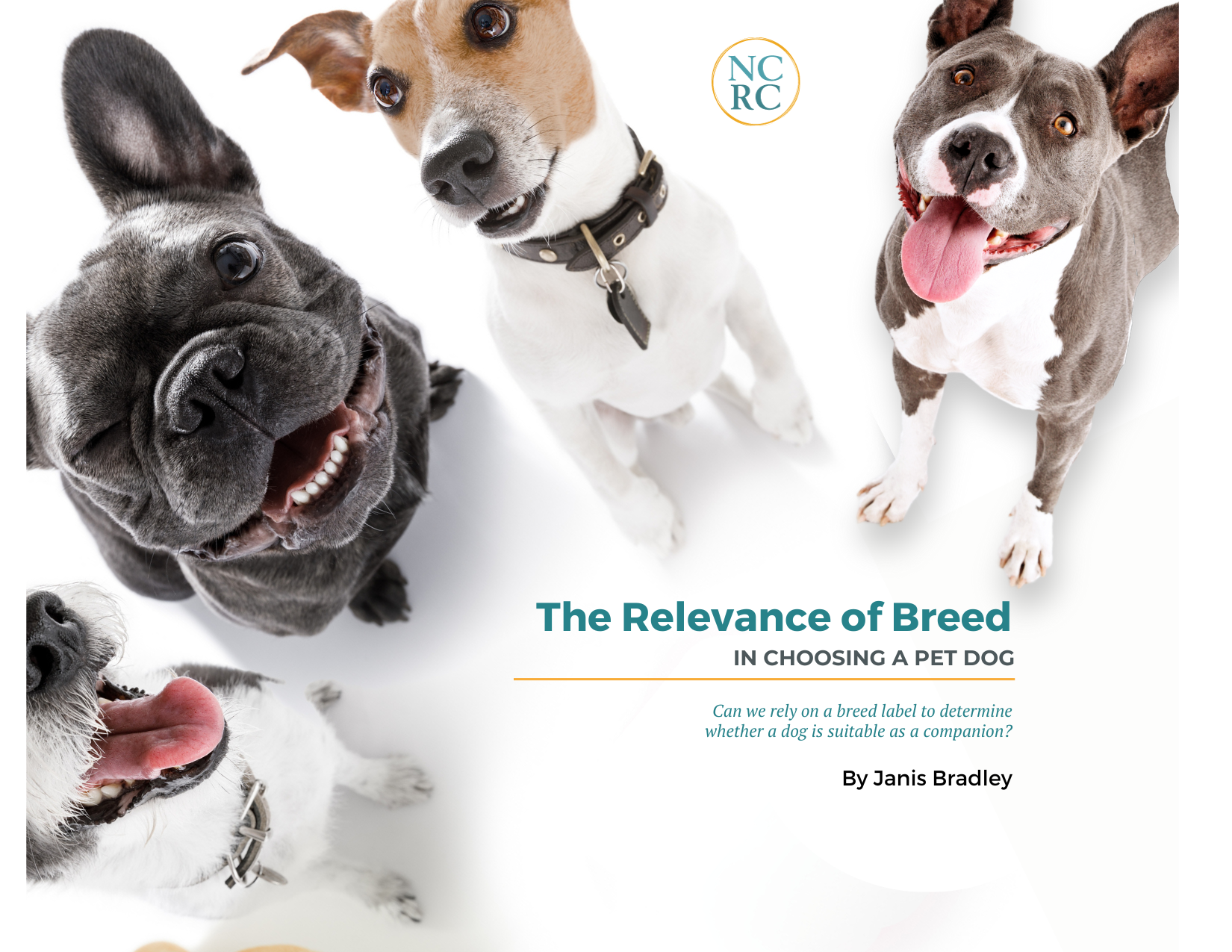The remarkable bond between humans and dogs spans millennia, crossing cultural and geographical boundaries. Nearly every scientific discipline, including biology, anthropology, sociology, psychology, and linguistics, has something to tell us about the value of the bond between our two species. At the National Canine Research Council we examine the myriad ways the human-canine bond enriches people’s lives.
The Evolution of a Partnership
Tens of thousands of years ago—evolutionary biologists differ on how many—a few brave wolves began living closer to people (Coppinger and Coppinger, 2001). This proximity benefited everyone—the proto dogs found a food source in human rubbish, and the people gained an impromptu janitorial service and an early warning system when intruders approached. Gradually interactions increased and individual connections were made as the former wolves evolved into the creatures we now recognize as dogs. These dogs began to perform tasks useful to the people they dwelt among. They helped with essential parts of making a living. They served as hunting partners; and when people began to keep livestock, they protected, confined, and moved those animals from place to place. Gradually, in many cultures, the primary role of dogs has become that of companions, leading to a bond characterized by loyalty, trust, and amity. This is possible because dogs developed the ability to form attachments with us in ways that we easily recognize and respond to: they are similar to the ways we bond with one another as humans (Topal, et al, 1998). This unique connection has played an integral role in shaping both human and canine societies. Burial sites going back thousands of years show dogs treated as beloved companions (Morey and Jeger, 2022), and the story of how this friendship benefits us both continues to unfold (Coppinger and Coppinger, 2001).
For the many people who seek this unique inter-species bond, the benefits can be profound. Of course, a dog in the family is not a panacea for all that ails us (Scoresby 2021). Our physical, emotional, and social well-being is complex and influenced by many factors. But the benefits of our friendships with dogs are so dramatic for such a large number of people that it is in society’s best interest to support them.
Ways That Living with Dogs Can Improve Our Lives
Enhance emotional well-being
The human-canine bond offers profound impacts on our emotional well-being. Interacting with a dog can alleviate stress, anxiety, and depression (Ramirez and Hernandez, 2014). Dogs provide love and support, becoming loyal confidants during challenging times. The simple act of petting a dog releases oxytocin, a hormone associated with relaxation and bonding, fostering emotional resilience in humans (Handlin et al 2011).
This can be particularly helpful for people coping with adversity (Applebaum, 2021). Consider these examples:
- Teens struggling with the sometimes brutal reality of adolescent peer culture find non-judgmental comfort with their dog.
- Veterans coping with PTSD report that, since their dog came to live with them, they have felt calmer, less lonely and depressed, less fearful, and generally better able to care for themselves. They report exercising and enjoying nature more (Stern, 2013).
- People experiencing discrimination of all kinds are supported by the loving acceptance of their dog (Applebaum, 2021).
People can also find comfort from the presence of dogs, even ones they don’t live with. Dogs are being brought into more kinds of anxiety-producing situations for just this reason, to provide access to some of that soothing brain chemistry that people stroking the dog on the couch next to them enjoy. We’ve become familiar with the idea of dogs visiting hospital patients and nursing-home residents. Children struggling with reading skills can gain confidence by reading to a dog, who, of course, never corrects their pronunciation or grows impatient with their efforts to sound out a word. Even the scariness of a dental visit or the grief of a visit to a funeral home can be eased for many people by contact with a calm, friendly dog.
Facilitate and support relationships among humans
It has become commonplace to point out that dogs often serve as a social lubricant. We know that a person walking a dog is often seen as more approachable and is in fact more likely to be engaged in casual conversation in public than a person walking alone (McNicholas, and Collis, 2000). And we know that social interaction is a powerful component of emotional and physical health. As the percentage of the population living alone continues to grow, the help with initiating social contact that dogs provide becomes ever more important.
This effect extends to people with potentially isolating major emotional and mental challenges (Brooks et.al., 2018). Veterans with PTSD who live with a dog find it easier to interact with people than those who don’t (Stern et.al., 2013). The dog need not be a trained assistance dog for this to be true—living with a dog friend is enough to spark these benefits for many.
And it goes even deeper. Scientists have begun to study how people speak to, for, and as their dogs, often to mediate their own intimate relationships, particularly as a safe way to express and resolve conflicts. Beloved dogs can serve as a sort of intermediary in potentially fraught interactions. So the linguist Deborah Tannen recounts how an argument is defused when the man says in baby talk tones to their tiny dog, “Mommy’s so mean tonight. You better sit over here and protect me” (Tannen, 2004). This can only happen when the person has mentally integrated the dog into the family with their own full identity as a family member, often one who is seen by everyone as particularly deserving of understanding and compassion.
Improve Physical Health
The physiological changes instigated by interacting with a dog have implications for physical health in addition to the emotional benefits described above. The changes in brain chemistry that make us feel calm and happy when we pet a dog also lower blood pressure and heart rate, much like often recommended strategies such as meditation and deep breathing for cardiovascular health interventions (Vrombrock and Grossberg, 1988).
Living with a dog often brings healthy lifestyle changes as well. The presence of a furry friend can help motivate daily walks, playful activities, and outdoor adventures, all of which contribute to a more active lifestyle. Some studies have linked dog ownership to lower blood pressure, reduced risk of cardiovascular diseases, and overall improvements in physical fitness (Arhant et.al., 2011). Moreover, the responsibility of caring for a dog instills a sense of purpose and routine, further enhancing our overall well-being (Hawkins, 2021).
Societal Impact
Some dog specialists still carry on their age-old role of practical assistance in everyday life. Their remarkable sense of smell allows them to detect things that people need to find, from termites in the foundation to cancer cells, and to do it more accurately than human-invented devices (Browne, et.al.2006). Dogs, of course, are indispensable in rescue and recovery efforts during disasters. Their ancient role as livestock guardians continues, discouraging predators and thereby fostering an environment where predators can coexist with cattle, sheep, and other domestic animals, minimizing conflict with ranchers’ interests (Potet et.al., 2021). Many are taught to go beyond their role as companions and perform specific tasks that make daily life easier for people living in a world that is often not designed with their needs in mind: the hearing-assistance dog alerts their handler to important sounds—the knock on the door, the phone, the fire alarm; the PTSD service dog provides a subtle barrier to keep anxiety-provoking people at a safe distance; the service dog brings objects and even food to the person who cannot reach them.

Matt Hersh
Education and Awareness
Continuing to learn about and appreciate the human-canine bond can promote awareness regarding responsible pet ownership. By fostering a deep understanding of dogs, we can ensure their well-being, nurture harmonious relationships, and prevent misunderstandings or conflicts. Encouraging proper training, socialization, and humane treatment is crucial for fostering a healthy bond between humans and canines.
Conclusion
Love is essential to a fulfilling life. And love is risky. A great philosopher, Francis Bacon, of the 16th century called loved ones “hostages to fortune.” Our bonds with dogs can create anxiety when essential resources are not available, compromising the powerful benefits we’ve outlined here (Applebaum 2021). The pet parent may feel guilty and undeserving of the relationship when they cannot afford veterinary care or even food for the dog. They may have to make the heartbreaking choice between a beloved canine family member and a roof over their heads. The victim of domestic abuse may be afraid of what the abuser will do to their dog if they leave. It is in society’s best interest to include support for this valuable part of human experience in every kind of social safety net. It is not in society’s interest to deprive some of its members of the profound benefits of sharing their lives with a canine best friend by limiting what that best friend may look like, based on prejudice and ignorance.
This enduring bond of humans and canines is a treasure that enriches our lives in ways we are only beginning to understand.
References
Applebaum, J.W., MacLean, E.L. and McDonald, S.E., 2021. Love, fear, and the human-animal bond: On adversity and multispecies relationships. Comprehensive psychoneuroendocrinology, 7, p.100071.
Arhant‐Sudhir, K., Arhant‐Sudhir, R. and Sudhir, K., 2011. Pet ownership and cardiovascular risk reduction: supporting evidence, conflicting data and underlying mechanisms. Clinical and Experimental Pharmacology and Physiology, 38(11), pp.734-738.
Brooks, H.L., Rushton, K., Lovell, K., Bee, P., Walker, L., Grant, L. and Rogers, A., 2018. The power of support from companion animals for people living with mental health problems: A systematic review and narrative synthesis of the evidence. BMC psychiatry, 18, pp.1-12.
Browne, C., Stafford, K. and Fordham, R., 2006. The use of scent-detection dogs. Irish veterinary journal, 59(2), p.97.
Coppinger, R. and Coppinger, L., 2001. Dogs: A startling new understanding of canine origin, behavior & evolution. Simon and Schuster.
Handlin, L., Hydbring-Sandberg, E., Nilsson, A., Ejdebäck, M., Jansson, A. and Uvnäs-Moberg, K., 2011. Short-term interaction between dogs and their owners: effects on oxytocin, cortisol, insulin and heart rate—an exploratory study. Anthrozoös, 24(3), pp.301-315.
Hawkins, R.D., Hawkins, E.L. and Tip, L., 2021. “I can’t give up when I have them to care for”: People’s experiences of pets and their mental health. Anthrozoös, 34(4), pp.543-562.
McNicholas, J. and Collis, G.M., 2000. Dogs as catalysts for social interactions: Robustness of the effect. British journal of psychology, 91(1), pp.61-70.
Morey, D.F. and Jeger, R., 2022. When dogs and people were buried together. Journal of Anthropological Archaeology, 67, p.101434.
Potet, B., Moulin, C.H. and Meuret, M., 2021. Guard dogs to protect sheep grazing in fenced pastures against wolf: a new and still challenging practice. Journal of Alpine Research| Revue de géographie alpine, (109-4).
Ramírez, M.T.G. and Hernández, R.L., 2014. Benefits of dog ownership: Comparative study of equivalent samples. Journal of Veterinary Behavior, 9(6), pp.311-315.
Scoresby KJ, Strand EB, Ng Z, Brown KC, Stilz CR, Strobel K, Barroso CS, Souza M. Pet ownership and quality of life: A systematic review of the literature. Veterinary Sciences. 2021 Dec 16;8(12):332.
Stern, S.L., Donahue, D.A., Allison, S., Hatch, J.P., Lancaster, C.L., Benson, T.A., Johnson, A.L., Jeffreys, M.D., Pride, D., Moreno, C. and Peterson, A.L., 2013. Potential benefits of canine companionship for military veterans with posttraumatic stress disorder (PTSD). Society & Animals, 21(6), pp.568-581.
Tannen, D., 2004. Talking the dog: Framing pets as interactional resources in family discourse. Research on Language and Social Interaction, 37(4), pp.399-420.
Vormbrock, J.K. and Grossberg, J.M., 1988. Cardiovascular effects of human-pet dog interactions. Journal of behavioral medicine, 11, pp.509-517.







